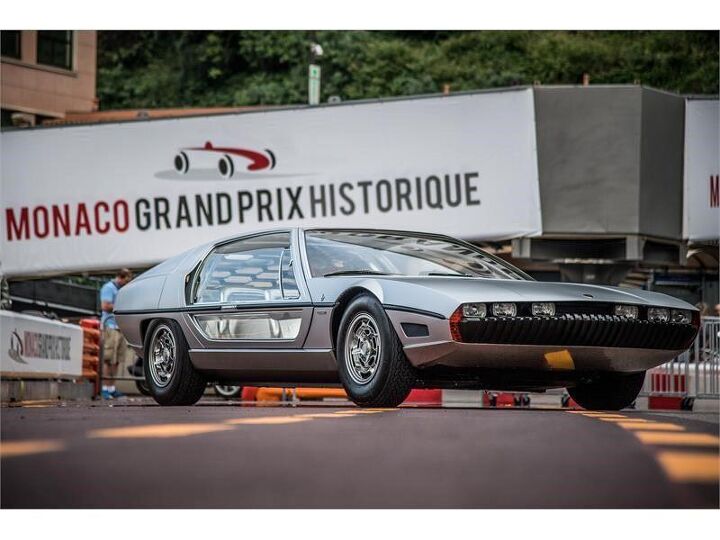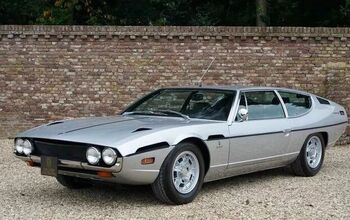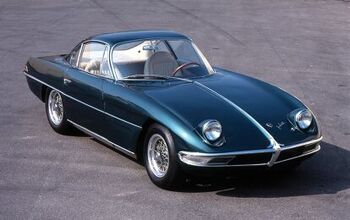Rare Rides Icons: Lamborghini's Front-Engine Grand Touring Coupes (Part VI)

We pick up our Lamborghini front-engine grand touring coverage at a time of design disappointments. Though the exotic Miura gave the company instant notoriety as it simultaneously created the super car class, the company’s other model was due for replacement. A more traditional looking two-door, the 400GT 2+2 was an edit of the 400GT Interim (2+1), which was itself an engine upgrade on the 350GT, the company’s first production car.
Ferruccio Lamborghini anticipated the need for a new design, and went in search of a 400GT replacement around the time it entered production in 1966. Lamborghini turned first to Carrozzeria Touring. But even though they penned the 350GT and 400GT designs, their two-seat shooting brake suggestion, Flying Star II, was not to Lamborghini’s taste.
In fact it was sort of like Touring didn’t read the prompt. An abandoned race car design called the 400GT Monza from Neri & Bonacini was also presented as an option. The firm built Lamborghini’s tube frames a few years before, but that didn’t lend them enough goodwill at Lamborghini to get their design accepted. Time for take three!
Time advanced to 1967, and the 400GT was in the middle of its production run. Lamborghini was willing to give another big name a shot: Marcello Gandini. Employed at Bertone at the time, Gandini took the four-seat grand touring directive more to heart than Carrozzeria Touring, but went even more wild everywhere else.
The basis for the new design was not the 400GT: Gandini chose the Miura’s chassis instead. It was lengthened by 4.7 inches overall (for a total of 103 inches), and strengthened considerably - a necessity with the lack of metal on the body. In finalized form, the body was 175 inches long, 67 inches wide, and only 43 inches high. With the exception of its overall height, the other dimensions were fairly similar to the extant 400GT.
What Gandini drew up was a wedge-shaped sports coupe with an enormous greenhouse, and very angular styling. The front end featured a heavily ribbed black bumper that terminated at large amber indicator lenses that were vertical, and integrated into the fender. Above there were six separate sealed beam headlamps, all square in shape.
The sharp front end featured a razor-thin hood line with no visible opening (it was a clamshell that opened from the A-pillar). The wide, flat hood had little detailing, and a sharp crease on either side that formed the upper half of the fender. A black trim strip went horizontally down the side of the coupe, and formed the shut line for the large hood.
A lower fender vent in front of the front tire was joined by a Bertone logo and model name, Marzal aft of the tire. The coupe’s side profile was dominated by a large glass area, interrupted only by the black piece of trim that allowed for door handle placement. The radical side profile included upper and lower panes of glass, set into a hexagon-shaped gullwing door.
The door frame itself formed the majority of the very fast A-pillar, which made for an enormous front windshield. There was no B-pillar, but the C-pillar was very thick and formed of a single piece of metal with the rear fender. It made for a flying buttress, but that design detail was covered by a honeycomb piece of black trim that concealed the true location of the vertical rear window.
The Marzal sat on a set of custom Campagnolo wheels, made of magnesium and with a hexagonal design theme. They measured 14 inches in diameter, and 6.5 inches wide. Tires specced were Pirelli Cinturato HS, 205-14s.
At the rear, the sharp character lines on the fenders drew up into an almost vertical fascia. There was a similarly ribbed bumper to the front end, along with typically Italian trapezoidal tail lamps.
A black mesh grille texture was added to the rear fascia and around the lamps. Underneath, a visible radiator was tucked under the lower valance, which provided cooling and a hint at where the engine was placed.
The interior of the Marzal was similarly wild, and played with the honeycomb theme present across the rear window. The silver exterior finish was contrasted by a two-tone blue and silver interior: The dash and pillars were covered in blue leather, while everything below the dash line was covered in metallic silver material. Speedometer and rev counter were a single hexagon shape, and set into a pod on the dash.
The rearview mirror was mounted from the dash on a stalk.
The honeycomb theming was replicated on the speakers, as well as in the center cluster where there were small auxiliary dials set into hexagons. Buttons and switches were mounted on the center stack, in multicolored plastic hexagons of their own.
Not content with the large side and front glass, there was also a large sunroof on the Marzal - at least it was tinted. In total, the coupe used 48 square feet of glass panel. The whole interior lounge was filled with light from the massive windows, and your author speculates a hothouse effect would occur even in winter. An air conditioning system was installed to prevent passengers from exiting as roasted chickens.
The finished Marzal was rear-wheel drive, and had its engine at the rear like a 911. Hardly the more conservative grand tourer Lamborghini specified, it also used a radical engine design: a 2.0-liter inline-six. The engine was reported to make 175 horsepower, and was developed by Gian Paolo Dallara. In essence, the 2.0 was half of the company’s 4.0-liter V12. Mounted transversely behind the rear passengers, it hung out over the rear axle.
Gandini’s design (like most of the things he penned) received immediate acclaim when it debuted in 1967 at the Geneva Motor Show. The radical approach to a four-seat sports car especially impressed Road & Track who declared the design was “...so fresh that everything else looks old fashioned.”
It’s at this point where the purpose of the Marzal is a bit unclear, and varies depending upon who’s providing the information.
Some sources indicate the coupe was intended to be a legitimate replacement for the 400GT, while others suggest it was just a fun design exercise. Perhaps Lamborghini asked for a legitimate GT replacement but was surprised by the results. At the time, he told Automobile Quarterly that the Marzal was just for show. “The Marzal was not developed as a production car. If you present a car like the Marzal at automobile shows… all the magazines report on the first page about it.”
Lamborghini went on to assert that it was better, and more affordable PR to “...build such a throwaway car” than to launch a traditional marketing campaign. Make your own call as to the intent behind the Marzal’s creation, but if it was just a fun design exercise Lamborghini certainly left choosing a production design down to the wire.
In any case, the Marzal remained a one-off concept, and Lamborghini moved on to a fourth 400GT replacement idea. Gandini’s design made an impact on Ferruccio, and he would return to Bertone in short order with another design request. Meanwhile, there was still the problem of the 400GT’s replacement. More next time.
[Images: Lamborghini]

Interested in lots of cars and their various historical contexts. Started writing articles for TTAC in late 2016, when my first posts were QOTDs. From there I started a few new series like Rare Rides, Buy/Drive/Burn, Abandoned History, and most recently Rare Rides Icons. Operating from a home base in Cincinnati, Ohio, a relative auto journalist dead zone. Many of my articles are prompted by something I'll see on social media that sparks my interest and causes me to research. Finding articles and information from the early days of the internet and beyond that covers the little details lost to time: trim packages, color and wheel choices, interior fabrics. Beyond those, I'm fascinated by automotive industry experiments, both failures and successes. Lately I've taken an interest in AI, and generating "what if" type images for car models long dead. Reincarnating a modern Toyota Paseo, Lincoln Mark IX, or Isuzu Trooper through a text prompt is fun. Fun to post them on Twitter too, and watch people overreact. To that end, the social media I use most is Twitter, @CoreyLewis86. I also contribute pieces for Forbes Wheels and Forbes Home.
More by Corey Lewis
Latest Car Reviews
Read moreLatest Product Reviews
Read moreRecent Comments
- Kjhkjlhkjhkljh kljhjkhjklhkjh Elon hates bad press (hence TWITTER circus) So the press jumping up and down screaming ''musk fails cheap EV'' is likely ego-driving this response as per normal ..not to side with tesla or musk but canceling the 25k EV was a good move, selling a EV for barely above cost is a terrible idea in a market where it seems EV saturation is hitting peak
- 1995 SC Wife has a new Ridgeline and it came with 2 years so I don't have to think about it for a while.My FIAT needed a battery (the 12V...not the drive battery), a replacement steering column cover and I had to buy a Tesla Charging adapter to use the destination charger at one of the places I frequent. Also had to replace the charge cable because I am an idiot and ran the stock one over and destroyed the connector. Around 600 bucks all in there but 250 is because of the cable.The Thunderbird has needed much the past year. ABS Pump - 300. Master Cylinder 100. Tool to bleed ABS 350 (Welcome to pre OBD2 electronics), Amp for Stereo -250, Motor mounts 150, Injectors 300, Airbag Module - 15 at the u pull it, Belts and hoses, 100 - Plugs and wires 100, Trans fluid, filter and replacement pan, 150, ignition lock cylinder and rekey - 125, Cassette Player mechanism - 15 bucks at the U Pull it, and a ton of time to do things like replace the grease in the power seat motots (it was hard and the seats wouldn't move when cold), Rear pinion seal - 15 buckjs, Fix a million broken tabs in the dash surround, recap the ride control module and all. My wife would say more, but my Math has me around 2 grand. Still needs an exhaust manifold gasket and the drivers side window acts up from time to time. I do it all but if I were paying someone that would be rough. It's 30 this year though so I roll with it. You'll have times like these running old junk.
- 3-On-The-Tree Besides for the sake of emissions I don’t understand why the OEM’s went with small displacement twin turbo engines in heavy trucks. Like you guys stated above there really isn’t a MPG advantage. Plus that engine is under stress pulling that truck around then you hit it with turbos, more rpm’s , air, fuel, heat. My F-150 Ecoboost 3.5 went through one turbo replacement and the other was leaking. l’ll stick with my 2021 V8 Tundra.
- Syke What I'll never understand about economics reporting: $1.1 billion net income is a mark of failure? Anyone with half a brain recognizes that Tesla is slowly settling in to becoming just another EV manufacturer, now that the legacy manufacturers have gained a sense of reality and quit tripping over their own feet in converting their product lines. Who is stupid enough to believe that Tesla is going to remain 90% of the EV market for the next ten years?Or is it just cheap headlines to highlight another Tesla "problem"?
- Rna65689660 I had an AMG G-Wagon roar past me at night doing 90 - 100. What a glorious sound. This won’t get the same vibe.









































Comments
Join the conversation
I've always liked the design of the Marzal. BTW, that's Prince Albert II of Monaco behind the wheel, at the 2018 Historic GP of Monaco. His father Prince Rainier III (along with the lovely Princess Grace) took it around the course for a parade lap in 1967, before that year's Monaco Grand Prix.
It's cool reading about how their cars were named. The Islero was named after a Miura bull (Miura bulls are bred for bullfighting) that killed a legendary matador in 1947.
Ah, one of my favorite Matchbox cars from the late '60's. Number 20, in a dark burgundy red if I recall correctly! I collected the cars (and still have them, in their original boxes), but when it came to exotic cars, I never knew anything about the actual cars themselves.